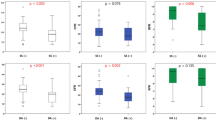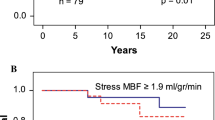Abstract
Background
Decreased myocardial flow reserve (MFR) in angiographically normal coronary arteries in patients with old myocardial infarction (OMI) has been reported.
Methods and Results
To clarify factors for the reduced MFR in OMI and to compare them with those in angina pectoris (AP), baseline myocardial blood flow (MBF) and MBF during dipyridamole administration were measured with nitrogen 13 ammonia positron emission tomography, after which MFR was calculated for 13 men with AP, 18 men with OMI, and 15 age-matched male control subjects. MFR was compared among the 3 groups in segments perfused by nonstenotic arteries. Baseline MBF in patients with OMI was significantly higher than that in patients with AP and control subjects. MBF during dipyridamole administration in patients with OMI was significantly lower than that in control subjects. MFR in patients with AP was 2.50 ± 0.91 (P < .05 vs control subjects [3.47 ± 1.25]), and that in patients with OMI was 1.83 ± 0.61 (P < .01 vs control and AP groups). Ejection fraction (EF) in patients with OMI was significantly decreased compared with that in patients with AP. However, there was no significant difference in the mean score of the individual risk factors between patients with AP and those with OMI. In the pooled data with AP and OMI, baseline MBF and EF were significant for the reduced MFR.
Conclusions
MFR and EF in patients with OMI were significantly decreased compared with those in patients with AP. Increased baseline MBF and decreased EF were significant factors for the reduced MFR in patients with AP and OMI.
Similar content being viewed by others
References
Gould KL, Lipscomb K. Effects of coronary stenoses on coronary flow reserve and resistance. Am J Cardiol 1974;34:48–55.
White CW, Wright CB, Doty DB, Hiratza LF, Eastham CL, Harrison DG, et al. Does visual interpretation of the coronary arteriogram predict the physiologic importance of a coronary stenosis? N Engl J Med 1984;310:819–24.
Camici P, Chiriatti G, Lorenzoni R, Bellina RC, Gistri R, Italiani G, et al. Coronary vasodilation is impaired in both hypertrophied and non-hypertrophied myocardium of patients with hypertrophic cardiomyopathy: a study with nitrogen-13 ammonia and positron emission tomography. J Am Coll Cardiol 1991;17:879–86.
Krams R, Kofflard MJ, Duncker DJ, Von BC, Carlier S, Kliffen M, et al. Decreased coronary flow reserve in hypertrophic cardiomyopathy is related to remodeling of the coronary microcirculation. Circulation 1998;97:230–3.
Inoue T, Sakai Y, Morooka S, Hayashi T, Takayanagi K, Yamanaka T, et al. Coronary flow reserve in patients with dilated cardiomyopathy. Am Heart J 1993;125:93–8.
Weismuller S, Czernin J, Sun KT, Fung C, Phelps ME, Schelbert HR. Coronary vasodilatory capacity is impaired in patients with dilated cardiomyopathy. Am J Cardiac Imaging 1996;10:154–62.
Nitenberg A, Valensi P, Sachs R, Dali M, Aptecar E, Attali JR. Impairment of coronary vascular reserve and ACh-induced coronary vasodilation in diabetic patients with angiographically normal coronary arteries and normal left ventricular systolic function. Diabetes 1993;42:1017–25.
Nahser PJ, Brown RE, Oskarsson H, Winniford MD, Rossen JD. Maximal coronary flow reserve and metabolic coronary vasodilation in patients with diabetes mellitus. Circulation 1995;91:635–40.
Yokoyama I, Momomura S, Ohtake T, Yonekura K, Nishikawa J, Sasaki Y, et al. Reduced myocardial flow reserve in non-insulin-dependent diabetes mellitus. J Am Coll Cardiol 1997;30:1472–7.
Yokoyama I, Ohtake T, Momomura S, Yonekura K, Woo SS, Nishikawa J, et al. Hyperglycemia rather than insulin resistance is related to reduced coronary flow reserve in NIDDM. Diabetes 1998;47:119–24.
Dayanikli F, Grambow D, Muzik O, Mosca L, Rubenfire M, Schwaiger M. Early detection of abnormal coronary flow reserve in asymptomatic men at high risk for coronary artery disease using positron emission tomography. Circulation 1994;90:808–17.
Yokoyama I, Ohtake T, Momomura S, Nishikawa J, Sasaki Y, Omata M. Reduced coronary flow reserve in hypercholesterolemic patients without overt coronary stenosis. Circulation 1996;94:3232–8.
Yokoyama I, Ohtake T, Momomura S, Yonekura K, Kobayakawa N, Aoyagi T, et al. Altered myocardial vasodilatation in patients with hypertriglyceridemia in anatomically normal coronary arteries. Arterioscler Thromb Vasc Biol 1998;18:294–9.
Yokoyama I, Murakami T, Ohtake T, Momomura S, Nishikawa J, Sasaki Y, et al. Reduced coronary flow reserve in familial hypercholes-terolemia. J Nucl Med 1996;37:1937–42.
Pitkanen OP, Raitakari OT, Niinikoski H, Nuutila P, Iida H, Voipio-Pulkki LM, et al. Coronary flow reserve is impaired in young men with familial hypercholesterolemia. J Am Coll Cardiol 1996;28:1705–11.
Sambuceti G, Parodi O, Marcassa C, Neglia D, Salvadori P, Giorgetti A, et al. Alteration in regulation of myocardial blood flow in one-vessel coronary artery disease determined by positron emission tomography. Am J Cardiol 1993;72:538–43.
Hutchins GD, Schwaiger M, Wolfe E. Positron emission tomography to quantitate myocardial perfusion. Am J Cardiol 1993;72:538–43.
Uren NG, Crake T, Lefroy DC, de SR, Davies GJ, Maseri A. Reduced coronary vasodilator function in infarcted and normal myocardium after myocardial infarction. N Engl J Med 1994;331:222–7.
Czernin J, Sun K, Brunken R, Bottcher M, Phelps M, Schelbert H. Effect of acute and long-term smoking on myocardial blood flow and flow reserve. Circulation 1995;91:2891–7.
Krivokapich J, Smith GT, Huang SC, Hoffman EJ, Ratib O, Phelps ME, et al. 13N ammonia myocardial imaging at rest and with exercise in normal volunteers. Quantification of absolute myocardial perfusion with dynamic positron emission tomography [see comments]. Circulation 1989;80:1328–37.
Kuhle WG, Porenta G, Huang SC, Buxton D, Gambhir SS, Hansen H, et al. Quantification of regional myocardial blood flow using 13N-ammonia and reoriented dynamic positron emission tomographic imaging. Circulation 1992;86:1004–17.
Yokoyama I, Ohtake T, Momomura S, Yonekura K, Nishikawa J, Sasaki Y, et al. Impaired myocardial vasodilation during hyperemic stress with dipyridamole in hypertriglyceridemia. J Am Coll Cardiol 1998;31:1568–74.
Campisi R, Czernin J, Karpman HL, Schelbert HR. Coronary vasodilatory capacity and flow reserve in normal myocardium supplied by bypass grafts late after surgery. Am J Cardiol 1997;80:27–31.
Czernin J, Muller P, Chan S, Brunken RC, Porenta G, Krivokapich J, et al. Influence of age and hemodynamics on myocardial blood flow and flow reserve. Circulation 1993;88:62–9.
Chan SY, Kobashigawa J, Stevenson LW, Brownfield E, Brunken RC, Schelbert HR. Myocardial blood flow at rest and during pharmacological vasodilation in cardiac transplants during and after successful treatment of rejection. Circulation 1994;90:204–12.
Di CM, Czernin J, Hoh CK, Gerbaudo VH, Brunken RC, Huang SC, et al. Relation among stenosis severity, myocardial blood flow, and flow reserve in patients with coronary artery disease. Circulation 1995;91:1944–51.
Czernin J, Auerbach M, Sun KT, Phelps M, Schelbert HR. Effects of modified pharmacologic stress approaches on hyperemic myocardial blood flow. J Nucl Med 1995;36:575–80.
Bottcher M, Czernin J, Sun KT, Phelps ME, Schelbert HR. Effect of caffeine on myocardial blood flow at rest and during pharmacological vasodilation. J Nucl Med 1995;36:2016–21.
Wu HM, Hoh CK, Buxton DB, Kuhle WG, Schelbert HR, Choi Y, et al. Quantification of myocardial blood flow using dynamic nitrogen-13-ammonia PET studies and factor analysis of dynamic structures. J Nucl Med 1995;36:2087–93.
Author information
Authors and Affiliations
Corresponding author
Rights and permissions
About this article
Cite this article
Yonekura, K., Yokoyama, I., Ohtake, T. et al. Reduced myocardial flow reserve in anatomically normal coronary arteries due to elevated baseline myocardial blood flow in men with old myocardial infarction. J Nucl Cardiol 9, 62–67 (2002). https://doi.org/10.1067/mnc.2002.119687
Received:
Accepted:
Issue Date:
DOI: https://doi.org/10.1067/mnc.2002.119687




